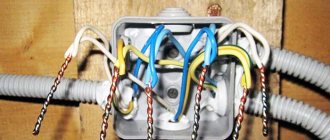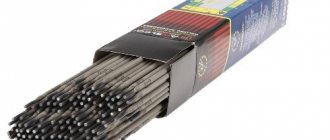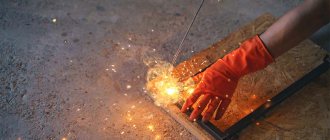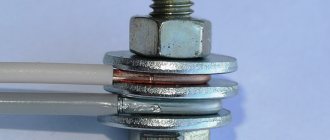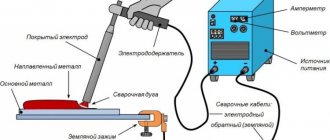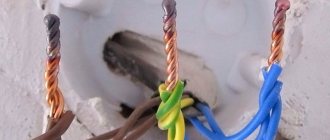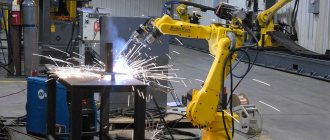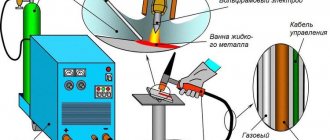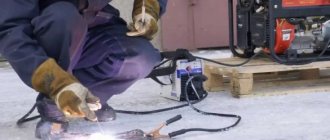Using an inverter
Copper wires, most common in residential buildings, are connected in several ways, but welding is considered the most reliable.
As a result of this connection, a homogeneous conductor is obtained, which ensures complete fire safety. Welding is carried out with direct or alternating current voltage from 12 to 36 V, and the welding current must be adjusted. Most welding inverters meet these requirements. They produce a special apparatus for welding copper wires, which is used by electricians. It has a power range of 1-1.5 kW and welding current adjustment in the range from 30 to 120 A.
Unlike conventional inverters, the equipment has less weight and dimensions; in addition, the ends of the welding cables are equipped with a special holder for carbon electrodes and a clamp with a large clamping surface for the conductors. If the farm already has an inverter welding machine, then you don’t need to buy a special device for welding copper wire.
For convenience, pliers and an electrode holder are welded to the welding cables or attached through a bolted connection. Any powerful clamp can play the role of a carbon electrode holder. Its handles must first be insulated.
The pliers are attached to the ground wire. They will hold onto the twist of the copper conductors being welded, while they will perform the important function of heat removal. This is necessary to protect the insulation from exposure to high temperatures.
Welding cable for inverter: types
There are few brands of conductors designed specifically for welding work. And there are only two types of cables that meet the above characteristics: KG and KOG.
Among craftsmen, the first type is in particular demand - flexible cable (KG). It should be used to connect mobile mechanisms to networks with alternating voltage up to 660 V with a frequency of 400 Hz. DC voltages up to 1000 V are also allowed.
KOG is a particularly flexible cable, analogous to KG, indispensable when working in hard-to-reach places, ensures quick changes in the position of equipment and guarantees freedom of action for the performer. It is recommended to use it for connecting electrode holders, automatic and semi-automatic installations to networks with alternating voltage up to 220 V with a frequency of 50 Hz or constant - up to 700 V. If the performer is thinking about which brand of cable on the remote control of the welding inverter is more suitable, then you can choose KOG.
Each of these brands has the following varieties, which are clearly distinguishable if you look at the markings:
- KOG-HL/KG-HL – cold-resistant, resistant to extremely low temperatures, down to -60°C;
- KOG-T/KG-T – tropical, resistant to various types of mold formations, operating temperature should not exceed +55°C.
You should also pay special attention to the following varieties:
- KGn has non-flammable insulation and should be used in fire hazardous conditions.
- KOG-U is used only in temperate climates, in the temperature range from -45 to +40°C.
Many performers have equipment of specific brands or manufactured by specific factories. Welders are especially often concerned with the question of which welding cable to choose for the Resanta inverter? Both brands: KG and KOG will be a suitable choice in such a case.
Process modes and features
Due to the limited welding currents, devices for fusing electrical wires can have very small sizes. Thermite welding of wires, which is widely used among specialists and is organized using a special powder mixture, makes it possible to further simplify the welding procedure. In this case, it is possible to significantly reduce the dimensions of the portable equipment used.
When carrying out ordinary electrical operations (including welding copper and aluminum wires), special equipment is used, which uses direct current of direct polarity to form an arc. The plus of the supply circuit is connected to the electrode holder in such a device, and its minus is connected to the grounding wire, which is usually called “ground”.
When welding with certain types of copper-coated electrodes, reverse polarity is used.
The magnitude of the welding current in any case is determined by the dimensions of the electrical wire harness being installed and the cross-section of the individual cores collected in it. During the welding process, the required value of this parameter is set using a regulator located on the control panel.
Various models of small-sized welded units provide adjustment of the output voltage. Some manufacturers and even home craftsmen further improve the design of their models by installing special current limiters in them. Data on the output parameters of such devices can be found in the tables of the dependence of the operating voltage and current on the cross-section of the wires being welded and their number in the twist.
Pros and cons of welding, its varieties
The advantages of connecting wires by welding are the absence of transition resistance, which is always present in twisted or bolted connections. This is especially true when laying wiring for powerful devices. The disadvantages are the need to buy or make your own welding machine designed for twisting.
Welding work requires some skills, so the electrician who will weld the strands needs to learn at least the basics of this craft.
When performing electrical installation work in production, various types of welding are used: standard, arc spot, plasma, torsion, electron beam, ultrasonic, or various combinations thereof. For domestic use, electricians most often use a device for spot and arc welding, which operates on carbon or graphite electrodes.
This solution allows you to obtain good quality connections at a minimum cost of the necessary devices and components. When making a wire welding machine, most attention should be paid to the following characteristics of the device:
- The current strength that the device can produce. Ideally this is a variable value.
- The voltage produced by the device is sufficient to cause an electric arc - usually 12-32 Volts.
- What kind of current does the welder use - alternating or direct? If you have experience in such work, you can use variable, but for beginners it is strongly recommended to start with constant.
Since welding different metals requires different currents and voltages, universal welding machines can necessarily adjust these values. In addition, when joining different materials, you may need special fluxes that will protect the metal from oxidation or the penetration of gases from the air into it. Most universal-purpose welding machines are quite bulky and heavy, but for small welding jobs you can find inverter welders for a relatively low price that are ideal for welding wires.
If you are welding copper wires that are used in home wiring, there is no need to use very high current and voltage, so it is possible to use small-sized welding machines that fit into a standard tool case.
Technical characteristics and criteria for selecting the best devices
Components of a welding inverter.
Let's look at the technical characteristics of the devices offered by their manufacturers - let's try to create a working list:
- Rated welding current or inverter power. One of the main characteristics is always present in the device passport. This is the current strength at which the device operates smoothly, stably, without overheating or overload. This indicator is closely related to the next one - PN.
- PN – load duration. A very important criterion is the ratio of working time to the time needed for a break due to overheating. The parameter is indicated as a percentage. If, for example, the PN is indicated at 60%, then after ten minutes of operation the device needs to cool down for the same ten minutes.
- Range of voltage surges: there are inverters that are able to operate stably in conditions where the voltage surges by 20 - 30%. This characteristic is especially important for working in rural areas. A welding inverter that operates only at a stable voltage of 220 V is not suitable in conditions of an unstable power grid.
- Welding current adjustment range. The wider this range, the more versatile the device, with which you can weld both thin metal sheets and massive cast parts. For budget models for home use, this range is very modest: 150 – 200A.
- Reducing no-load voltage - RDThis is about reducing the voltage to a safe level of 10 - 12V when the device is idle. The required current level instantly returns when the electrode touches the workpiece.
- The diameter of electrodes for welding work is usually in the range from 1.4 mm to 6.0 mm. This indicator depends on the current generated by the inverter. Allowable diameter sizes are always indicated in the technical specifications of the devices. When purchasing a device, it is better to choose models with at least a small margin for this criterion, just in case. “In any case” there is a risk of a voltage drop in the network downwards.
- Temperature operating conditions. The most important criterion for Russian regions, especially in cold climate zones. Typically, the acceptable temperature range is considered to be from -15°C to +40°C. But if you live in a region with cold winters, look for devices with a wider temperature range. Do not forget that you need to store the inverter device taking into account the same figures: if it is a warehouse, it must be heated. At the same time, we note that welding machines in the form of inverters do not like excess moisture due to the risk of condensation. It’s not the device itself that’s capricious, it’s its electronic circuits that are capricious: it is what it is. Temperature sensitivity is considered one of the disadvantages of inverters in general.
- Ventilation. In addition to too low or too high temperatures and high humidity, the electronic circuits of inverters do not like dust. Here you need to make a difference: if professional and industrial devices must include special tunnel ventilation systems, then for household handbrake systems these requirements are not so critical. However, any inverter needs to be cleaned of dust at least twice a year.
- Arc force is a great additional feature, especially useful for beginners. This is an automatic increase in welding current when the electrode approaches the surface of the workpiece. As a result, the risk of sticking is reduced, the quality of the arc is improved, and splashes of molten metal disappear.
- Hot start is another additional option for quickly igniting the arc: this again automatically increases the strength of the welding current, but this time at the moment the welding arc is ignited. It greatly increases the overall comfort of work and, consequently, mood.
- Anti-stick or anti-stick is the third additional option: the moment the electrode touches the surface of the metal workpiece, the welding current is automatically turned off for a very short time. When the electrode is removed, it is immediately restored.
Graph of voltage and output current.
Now you need to decide which inverter-type welding machines you need to consider from the point of view of the welding process and operating mode.
There are only three such types:
- MMA – devices for manual arc welding;
- MIG/MAG – semi-automatic devices;
- TIG – automatic machines for welding in argon.
The third package will not be “bare” TIG machines for argon welding, but universal inverters that allow you to work using different technologies, including TIG. We are interested in reviewing and choosing the most suitable inverter for home use or a small private workshop - how to choose the right welding inverter for your needs. Let large productions deal with industrial machines; they will figure it out without us.
The principle of operation of arc welding - device diagram
Since welding requires a large current, the basis of any welding machine is a step-down transformer - a loss in voltage is always accompanied by a gain in current and vice versa. A standard diode bridge is used to convert alternating current into direct current, and a capacitor is used to smooth out ripples.
A noticeable disadvantage of using a direct current device is that the diodes and capacitor used are rather large and they significantly increase the weight of the welding machine, which is initially made portable.
Experts also recommend installing additional resistance at the input or output of the diode bridge, since diodes “do not like” a short circuit in its pure form.
Many craftsmen manually assemble a welding machine for welding copper wires, which produces an arc from alternating current and use them successfully. Therefore, it is impossible to say unequivocally that it is necessary to use a direct current device - everyone chooses the necessary model according to their skills. If an AC welding machine is manually assembled, then the diode bridge and capacitor are simply thrown out of the circuit.
A necessary skill that you will have to master to use an AC welding machine is to learn “by eye” to determine how long you should hold the ignited arc of the electric discharge so that the end of the twist heats up and fusions.
The most common way to make a negative contact for welding is with old pliers that hold the wires.
For the phase, take a clamp that can hold the graphite rod. The design of the clamp can be very diverse - from a screw connection to the so-called “crocodiles”, both home-made and factory-made. To connect to the welding machine itself, cables with a cross-section of about 10 mm² are used.
Despite the fact that a device assembled in an industrial environment is an order of magnitude more expensive than a homemade one, its price is not exorbitant and allows you to purchase such a welding machine even on a limited budget. The advantages of its use are obvious - it is a precisely calculated design with a current regulator, which allows you to work with different types of metals and the number of wires being welded.
Useful tips
Experts recommend using graphite electrodes without copper plating. This is due to the fact that when the angle burns out, its resistance will drop, which can lead to long contact. This will subsequently affect the quality of the connection.
It is also worth considering the following points:
- Before starting work, the end of the graphite electrode is processed - a recess is formed on it. This will facilitate the formation of a properly shaped adhesive ball. As an alternative to factory-made graphite electrodes, you can consider using current collectors used in trolleybuses or battery rods. They are relatively small in size and can be attached to the inverter handle. It is mandatory to use protective equipment - a welder's mask (dark glasses), gloves and long sleeves.
Upon completion of welding of copper wires, it is necessary to check the quality of the connection. To do this, they put the maximum permissible load on the network and check whether there is heating on the twist. Only then can the connection be completely isolated.
Features of wire welding
First you need to make the correct installation of the wiring - choose its optimal diameter, correctly position it in the walls of the room. To distribute lines, special boxes are installed. There it becomes possible to redirect the supply of electricity from the central wire to the auxiliary one.
Welding wires in a box has the following nuances:
- Use of inverter welding machines with power up to 1 kW. These can be factory models or homemade ones.
- Electrodes - graphite or carbon. It is not recommended to use copper-plated rods, as this may affect the quality of the connection.
- Unlike soldering, no flux or other types of additives are required during welding.
- Wire heating temperature control. Otherwise, there is a high probability of partial destruction or change in the properties of the insulation.
Work is carried out only when the network is completely de-energized; a protective mask and special work clothing are used during welding. The diameter of the electrodes depends on the calculated current strength, which, in turn, is calculated depending on the diameter of the cores and their number.
Welding equipment terminals
The selection of clamps intended for attaching the wire to the power source should be treated with special attention. The right choice can not only make the welder’s work safer, but also ensure good weld quality
It is necessary to take into account both the maximum amount of current and the weight of the cable that is connected to the clamp
It is also necessary to pay attention to how reliably the terminals are in contact with the surface of the workpiece. The contact depends on the elasticity coefficient of the springs with which the clamps are equipped
There are three main types of terminals used for grounding:
- magnetic clothespin;
- “crocodile” retainer, which got its name because of its resemblance to the jaws of a reptile;
- clamp.
The first two species are most widespread. The magnet allows you to attach to any surface, for example, on parts of an unusual or rounded shape - where there are certain difficulties with fixation.
The use of an alligator clip ensures secure fastening. The clamp itself is easy to use. Its service life depends on the condition of the spring, which is not recommended to overheat. We are talking about one of the main elements of the terminal: if it fails, it will negatively affect the functioning of the clamping device itself.
Features of welding aluminum wires
The use of aluminum cores is prohibited by the current PUE. But in some older homes you can still find this type of wiring. A complete replacement entails financial costs and can take a long time. But for welding aluminum wires it is necessary to take into account a number of specific points.
They are as follows:
- cleaning contact parts from oxide film;
- use of special flux for aluminum welding;
- treating the welding area after cooling with quick-drying varnish.
The use of mechanical types of connections for aluminum wires is not recommended. Also, you cannot twist wires made of this material with copper ones. To do this, use special adapters.
Working with aluminum
Carbon electrodes are used to connect even aluminum products, which are traditionally considered difficult to weld. Aluminum has low density, significant thermal conductivity and resistance to corrosion.
This metal melts at a temperature of 660 °C, and it combines quite well with oxygen, which is why it is covered with a film of aluminum oxide (chemical formula - Al2O3).
The presence of such a film, as well as the ease of formation of cracks and pores in the weld metal, are the main difficulties encountered when welding aluminum. But the use of carbon electrodes makes it possible to cope with them.
In particular, this is the method used to connect aluminum busbars in electrolysis shops. Tires are traditionally butt welded on a graphite or aluminum backing.
Graphite plates with cutouts opposite the seam are mounted on the sides of the tires. These cutouts make it possible to move the end and start points of the seam beyond the boundaries of the working section.
Alternative connection methods
It is not always possible to weld current-carrying conductors. Difficulties are caused by the lack of an inverter (welding machine) or insufficient experience in performing this type of work. In this case, it is recommended to consider alternative wire connection options.
Methods for forming reliable contact between several cores:
- Twisting (crimping). It differs from the process described above in the absence of a welded joint. It is not recommended to do this, since there is a high probability of lack of direct contact between several wires, which can lead to a resistive effect - heating.
- Soldering. Unlike welding, solder and flux are used. They should fill the space between the twisted wires. Convenient for connecting small cross-section cores.
- Contact clamps. They can be screw or mechanically fixed. The former are used for switching a large number of wires. Mechanical fixation is recommended for connecting large diameter cores for networks with a high load rating.
For each technique, an individual procedure for performing work is adopted. But in any case, generally accepted safety rules are followed.
No. 6. Duty cycle
The ratio of the duration of work and rest of the welding machine is usually reported as a percentage. For example, a duty cycle of 60% means that out of every 10 minutes the device will work for 6 minutes, the rest of the time it will cool down and rest. For your dacha and home, you can take welding machines with a duty cycle of 60-70%. If welding is the main activity, you will need a machine with a duty cycle of 80-100%, and such are not uncommon among professional equipment. As a rule, the duty cycle indicator is tied to the maximum current. If you use a lower current, then the duration of continuous operation will increase.
Good professional inverter welding can provide up to 8 hours of continuous operation.
Types of electrodes
Round
The simple “round” type can be used indefinitely. The cross-section of the rod ranges from 3.2 to 19 mm. There are also so-called “round endless” electrodes. Of course, they have strictly limited sizes. However, the efficiency fully justifies the main name.
The diameter of the “endless” elements varies from 8 to 25 mm. Most often they are used when welding using a special machine. Both options are acceptable for “simple” welding work. However, any types of coal models, due to their infusibility, consume little.
There are also several types of such electrodes that deserve separate analysis.
Semicircular
The semicircular electrode usually has a diameter of 10 to 19 mm. Such products are often recommended for cutting metal workpieces. It is semicircular electrodes that are used by most amateur and professional welders. The seam has an optimal shape. Creating an edge with a semicircular electrode is easy.
Rectangular
They are also sometimes called flat - but not everything is so simple. When traders say the word “flat”, they may also mean square. The section size ranges from 8 to 25 mm. Most often, such tools are used when it is necessary to repair a defect in a steel casting. They are rarely used for other purposes.
Hollow
It is not often possible to find this type of electrodes. Their typical size ranges from 5 to 13 mm. It is this solution that is suitable for forming U-shaped outline lines. Hollow structures are also excellently used for vacuum welding. The pressure in the working chamber should not exceed 665 Pa.
Graphite electrode for welding
Due to its technical characteristics, the graphite electrode is easy to cut, consumes more slowly, and does not crack during welding. As practice shows, welding of wire cores is carried out in distribution boxes. The boxes are located quite high, so you will need to use portable welding equipment for welding.
Industrial devices are used for these purposes, the use of which is advisable in a professional sense. If possible, you can assemble the welding machine yourself. However, for most people, inverter-type devices, which are presented in a large assortment in stores, are perfect. They are compact, mobile, lightweight and also have the ability to adjust the welding current you need.
Types of electrodes for welding copper wire cores
When welding copper conductors, appropriate electrodes must be used. We have already mentioned carbon electrodes. There is also a graphite type of electrodes. Battery rods, brushes of commutator motors and similar products made of graphite can be used as an electrode in household use.
Graphite rods are a good replacement for purchased electrodes, with the only exception that they do not have copper plating, but this can be solved by improving the holder. To do this, it will be necessary to use an alligator clip, both for the electrode and for the ground connection. They will not be as bulky as standard ones, so it will be more convenient for you to work in switchboards. Of course, you will need to take care of additional insulation of the handles.
Graphite and carbon electrodes have a general similarity: both have a melting point 4 times higher than the melting threshold of copper itself. Because of this property, the consumption of electrodes when connecting electrical wiring is very low.
Please note that the electrode heats up to a high temperature instantly, so there is a risk of overheating the material being welded, which, in turn, can damage the insulation in the cable. The welder needs to know these factors in order to be careful when installing electrical wiring.
Differences between graphite and carbon electrodes
Despite the similarity of graphite and carbon rods when installing wiring, their characteristics differ:
- The first difference is the price. Graphite products are more affordable;
- if the carbon rod is completely black, then the graphite electrode has a gray-dark color with a metallic tint;
- welding using a carbon electrode requires a certain skill from the welder, since the carbon rod creates an arc of enormous temperature, which can lead to the destruction of the welded twist. At the same time, huge temperature indicators occur at low current. Based on this, carbon electrodes will be useful to a welder with a weak welding machine;
- for those who own an inverter device that is equipped with a current regulator, it is better to use graphite rods. When working with them, less skilled craftsman is required. In addition, the connection of wire cores after their use is characterized by greater strength, better quality, and increased resistance to oxidation than after the carbon welding process.
How to cook with carbon electrodes
Carbon arc welding was invented by Russian engineer Nikolai Benardos back in 1882. In fact, this is the oldest method of electric welding. Today, carbon or graphite electrodes are used much less frequently than metal electrodes, but they still have their own scope of application.
Properties and varieties
A carbon electrode is a solid rod consisting of coal (coke) and several additives. Resin is used here as a binding element.
These rods can be used to weld all types and varieties of metals - from refractory and heavy to light and porous. The diameter of the carbon electrode can vary from 1.5 to 25 mm, and the length - from 25 to 300 mm (the longest are used when the parts to be connected are located in a hard-to-reach place). They can also have different shapes:
- round;
- semicircular;
- rectangular;
- hollow.
In most situations, round and semicircular electrodes are used for work - this is the best option for obtaining a standard weld.
Rectangular products are mainly used to seal defects on steel surfaces, while hollow ones are characterized by the fact that they are capable of creating a U-shaped groove at the joint.
It is also worth knowing that in addition to the usual ones, there are copper-plated carbon electrodes. They are coated with copper to increase strength, but all other performance properties remain approximately the same.
Process Features
Electrodes made from coal differ from metal ones in that they are infusible. This means that during welding they act as a conductor of electricity, but do not become part of the weld pool.
During operation, the carbon rods heat up to very high temperatures. And if you continue heating, then almost immediately they will go from a molten state to a boiling state (by the way, coal boils at a temperature of 4200 ° C).
Due to the characteristics of the material, only direct electric current of straight polarity can be used in the welding process. Accordingly, the minus (cathode) here should be on the electrode, and the plus (anode) on the metal surface of the product.
When working with carbon electrodes, the welder usually requires filler elements. In this case, welding can be done in two ways:
- from left to right (in this case, the additive is behind the electrode);
- from right to left (there is an additive in front).
Interestingly, when welding from left to right, thermal energy is used more efficiently, and this allows you to increase the speed of work. However, in practice you can often find the “right to left” technology - it is more familiar.
In some situations, you can do without an additive, for example, when flanging thin metal products or when welding corner joints . Moreover, if you use a carbon electrode without additives to join metal sheets with a thickness of up to 3 mm, then the productivity will be an order of magnitude greater than when welding with other electrical conductors.
Use in home workshops
To work with carbon electrodes at home, a standard electric arc welding machine is suitable. Since the thermal conductivity of carbon rods is low, an arc can be created with a current of only 3-5 Amperes.
Moreover, this electric arc, if necessary, extends to a length of 30-50 millimeters. The electrode evaporates slowly and does not stick to the metal, so it is quite easy to guide the carbon arc in the direction of the future seam.
The skills needed to perform simple jobs (such as welding wires, welding thin metal plates, etc.) are acquired very quickly in this case.
Home craftsmen should not cook outdoors, but strictly indoors. The carbon arc reacts to wind blows, gas flows, magnetic fields and other influences.
In order not to waste time rearranging the electrode in the holder and so that it does not get too hot during welding, it can be sharpened at both ends in advance. When one end overheats, the electric holder is rotated 180° and welding continues with the other end.
Craftsmen who do not have too many consumables on hand should use this advice.
Some specialists use carbon and graphite electrodes to weld copper busbars at transformer substations. And in home handicraft workshops, such electrodes can, for example, weld copper wires.
Bronze rods would be a good filler material in this situation. The diameters of such rods are selected depending on the thickness of the parts being welded and are calculated using special formulas.
In addition, carbon electrodes can be used to perform not only welding work, but also cutting operations on metal products.
Working with aluminum
Carbon electrodes are used to connect even aluminum products, which are traditionally considered difficult to weld. Aluminum has low density, significant thermal conductivity and resistance to corrosion.
This metal melts at a temperature of 660 °C, and it combines quite well with oxygen, which is why it is covered with a film of aluminum oxide (chemical formula - Al2O3).
The presence of such a film, as well as the ease of formation of cracks and pores in the weld metal, are the main difficulties encountered when welding aluminum. But the use of carbon electrodes makes it possible to cope with them.
In particular, this is the method used to connect aluminum busbars in electrolysis shops. Tires are traditionally butt welded on a graphite or aluminum backing.
Graphite plates with cutouts opposite the seam are mounted on the sides of the tires. These cutouts make it possible to move the end and start points of the seam beyond the boundaries of the working section.
When welding aluminum surfaces using carbon arc welding, the filler material is wire or rod made of the same metal. To ensure that the oxide film does not interfere and does not affect the result, AF-4A flux, which is a homogeneous, fine white powder, is added to the edges of the seam.
Assembly instructions
Assembling the device with your own hands will require minimal skills in working with hand tools. For convenience, the manufacturing process should be divided into 5 stages:
- Preparing the body. It is selected based on the dimensions of the transformer.
- Search and installation of a transformer. Checking its performance.
- Selection of power cable. Protection of the device from overload.
- Installation of output terminals. Other connection methods.
- Selection and installation of holder and electrode. DIY alternatives.
Welder body
The easiest way is to use a ready-made housing from any electrical device. For example, from a car charger or a suitable uninterruptible power supply from a computer. It is desirable that the housing be made of dielectric material (plastic, carbolite). This will be a plus in favor of the security of the future device. If none of the above options is suitable, then the easiest way is to make a body from thin sheet iron 1-3 mm thick.
Transformer selection
The required transformer can sometimes be found in stores. Another option is to look for it from friends or wind it yourself.
The primary winding of the transformer is designed for 220 V. The iron is selected based on the overall power of 200-1000 W. Low-power transformers are suitable for welding thin wires, and high-power transformers are suitable for thick ones.
The secondary winding of the transformer is wound with wire from 35 kW. mm, because she will have to experience short circuit currents. It is better to use copper as the material for the output winding. This will reduce heating losses.
Power cables
The 220 V power supply cable is selected based on the power of the transformer. For devices with a consumption of 1 kW, its cross-section is taken to be at least 4 square meters. mm. A thick cable is also better because it is more difficult to break or break during repairs and wiring.
To protect the device, it would be useful to install a fuse or circuit breaker in the primary winding circuit. This way the transformer will be protected from overcurrent.
Terminal Applications
If possible, the use of terminals should be avoided. They tend to become loose and burn over time, especially at high currents in the secondary winding of the transformer. The most reliable connections are made by welding, soldering or crimping.
In some cases, terminals are convenient. For example, at the output of a welding transformer. Using terminals, you can move the device separately from its wires. The main thing is to ensure that during operation the terminals do not oxidize, dangle or overheat. It is permissible to periodically remove dirt using a file.
Electrode holder
Welding is carried out with a graphite electrode coated with a thin layer of copper. This combination provides the good conductivity of copper combined with the heat resistance of graphite. Similar electrodes are commercially available. If you couldn’t find them, you can make them yourself from a graphite brush of an electric motor. It should be taken larger and cut with a hacksaw to the desired size.
Homemade holders for welding. The holder is made of a pair of copper bars and bolts for tightening. The device must securely clamp the graphite electrode.
Do-it-yourself welding machine for welding small parts
Quite often in the practice of any owner, the need arises to connect metal parts. One such connection method is welding. But what to do if you don’t have a welding machine? Of course, you can buy it, but you can also make the simplest device yourself, and in almost half an hour.
Prologue
The simplest prototype of a welding machine - a lighting electric arc projector - was used back in the mid-twentieth century in film studios during the filming of films.
At home, it is possible to make a simple, rare homemade welding machine from a 200 W autotransformer. (An approximate diagram of an autotransformer is shown in the figure). The output voltage is regulated by rearranging the television plug in the sockets.
On the secondary winding of the transformer, you need to find two terminals at which the voltage will be about 40 V. All that remains is to connect the graphite electrodes to these terminals and the welding machine is ready! However, it must be taken into account that when using such an autotransformer for welding purposes, it is advisable to have a good knowledge of the basics of electrical safety, since galvanic isolation from the electrical network is not ensured.
The scope of application of such a homemade welding machine is quite wide: from welding metal products to hardening the working surfaces of the tool.
Examples of Voltaic Arc Applications
In the practice of radio amateurs, at times there is a need to weld or very strongly heat small parts. In such cases, there is no need to use a serious welding machine, because... To create high-temperature plasma it is not necessary to have special equipment.
Let's look at several examples of the practical application of the Voltaic Arc.
Welding filament magnetron with power buses
In this case, welding is simply necessary, although many, when faced with such a difficulty, replace the magnetron. But most often there are only two malfunctions: the filament breaks at the point (item 1) and the feed-through capacitors (item 2) fail due to breakdown.
The picture shows a magnetron from a Kenwood microwave oven, which worked after repair for more than twenty years.
DIY thermocouple repair
Of course, making a thermocouple is a completely hopeless task, but it happens that it needs to be repaired if the “ball” breaks. Typically, such thermocouples are found in multimeters that have a temperature measurement mode
Heating High Carbon Steel
If it is necessary to change the shape of the spring or make a hole, it should be taken into account that the hardened spring is too hard for drilling and too brittle for making a hole with a punch.
And in the case of hardening a steel tool (made from tool steel), it is enough to heat the working surface to a crimson color and cool it in a bath with machine oil. The figure shows a hardened screwdriver blade after machining the working edge.
How to get a Voltaic Arc?
Small welding work can be performed using a transformer with a power of 200 watts and an output voltage in the range from 30 to 50 volts. In this case, the welding current should be 10-12 Amps. There is no need to worry about the transformer overheating, since the arc burns only for a short time.
An ordinary laboratory autotransformer LATR with a current of 9 Amperes is also suitable. However, the full extent of the danger must be taken into account due to the fact that there is no galvanic isolation from the electrical network.
In order to prevent damage to the graphite roller of the LATR current collector, it is advisable to limit the input current by using a fuse. Then an accidental short circuit in the electrode circuit is no longer scary.
Electrodes can be any graphite rods of simple pencils (preferably soft).
The metal part of the electrical terminal block is used as a holder for the lead.
This figure shows an example of a holder using a terminal block, with one hole used to attach the handle, and the second to clamp the lead into the terminal.
In order to prevent melting of the disposable syringe (item 3) when the terminal block (item 1) is heated, fiberglass washers (item 2) are used. And for a standard connection to the cable, you can use the standard socket from the device (pos. 4).
So, the connection diagram is quite simple: one terminal of the secondary winding is connected to the holder, and the second terminal is connected to the part being welded.
There is another option for attaching the electrode holder using an electrical terminal. The second holder will be needed in case of welding metal products with the same melting point or if it is necessary to heat the metal product (hardening, changing shape).
Diagram for connecting two graphite electrodes to the secondary winding of a transformer.
To protect your eyes from corneal burns and from sparks, it will not be enough to use dark glasses due to the low density of light filters. The following device can be made: the frame of binocular glasses with the lenses removed can serve as a shield; The filter is attached using a stationery clip. Or you can use amateur radio glasses used in SMD technologies.
When welding copper with nichrome or steel, you will need flux. When a small amount of water is added to sodium tetraborate (borax) or boric acid, a paste is obtained, which is used to lubricate the welding areas.
The materials for making flux can usually be found at a hardware store. You can also use Borax insect repellent containing boric acid.
Recommended welding current modes for different conductors
The magnitude of the welding current depends on the cross-section size and the number of strands in the twist: the thicker the twisted bundle, the greater the current value must be set on the welding machine:
- 2 cores, cross section of each 1.5 mm² - 70 A;
- 3 cores, cross section of each 1.5 mm² - 80-90 A;
- 2-3 cores, cross section of each 2.5 mm² - 80-100 A;
- 3-4 cores, cross section of each 2.5 mm² - 100-120 A.
The specified welding current modes are indicative. Wires from different manufacturers differ in chemical composition and declared cross-section, and welding devices also differ in their characteristics. Therefore, it is better to select the value of the welding current practically on a small section of the same wire. When choosing a mode experimentally, the optimal one will be when the arc is stable and the tip of the electrode does not stick to the welding site.
For modern inverter-type devices:
- stable welding discharge, ensuring high-quality welding work;
- When welding, liquid metal does not splash;
- the arc does not blind the welder due to the low melting point of copper;
- inverters are not heavy, their dimensions are small, which allows them to be carried to the installation site on a belt.
Safety requirements for graphite welding
A graphite electrode allows you to create reliable connections between parts of various types of metal structures, but welding is extremely important to carry out taking into account safety standards.
Copper welding diagram using a graphite electrode.
Let's describe them in detail:
- the current supplied to the welding cables must be turned off before starting work in order to protect yourself from electric shock;
- operations using a welding machine should be performed only in special clothing, shoes and using personal protective equipment that will help protect the eyes, hands and skin of the body from burns;
- the work site is cleared of flammable items, which will avoid the risk of fire;
- after welding one twist, it is important to wait until it cools down, and only then proceed to work with the next one;
- excessive haste and unwillingness to wait until the first twist cools down can lead to a burn on the welder’s body;
- the twists are insulated after welding using heat-shrinkable tubing and electrical tape.
If you do not adhere to the safety requirements described above when performing welding work with graphite rods, you can get a burn to the skin, retina, etc.
